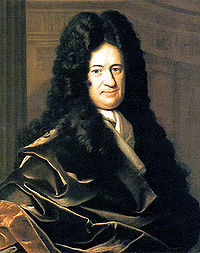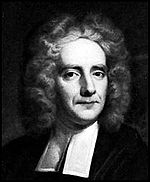
Leibniz-Clarke correspondence
Encyclopedia


Debate
Debate or debating is a method of interactive and representational argument. Debate is a broader form of argument than logical argument, which only examines consistency from axiom, and factual argument, which only examines what is or isn't the case or rhetoric which is a technique of persuasion...
conducted in an exchange of letters between the German
Germany
Germany , officially the Federal Republic of Germany , is a federal parliamentary republic in Europe. The country consists of 16 states while the capital and largest city is Berlin. Germany covers an area of 357,021 km2 and has a largely temperate seasonal climate...
thinker Gottfried Wilhelm Leibniz and Samuel Clarke
Samuel Clarke
thumb|right|200px|Samuel ClarkeSamuel Clarke was an English philosopher and Anglican clergyman.-Early life and studies:...
, an English
England
England is a country that is part of the United Kingdom. It shares land borders with Scotland to the north and Wales to the west; the Irish Sea is to the north west, the Celtic Sea to the south west, with the North Sea to the east and the English Channel to the south separating it from continental...
supporter of Isaac Newton
Isaac Newton
Sir Isaac Newton PRS was an English physicist, mathematician, astronomer, natural philosopher, alchemist, and theologian, who has been "considered by many to be the greatest and most influential scientist who ever lived."...
during the years 1715 and 1716. It was ended by the death of Leibniz in November 1716.
Although a variety of subjects is touched on in the letters, the main interest for modern readers is in the dispute between the absolute
Absolute time and space
Originally introduced by Sir Isaac Newton in the Philosophiæ Naturalis Principia Mathematica, the concepts of absolute time and space provided a theoretical foundation that facilitated Newtonian mechanics...
theory of space
Space
Space is the boundless, three-dimensional extent in which objects and events occur and have relative position and direction. Physical space is often conceived in three linear dimensions, although modern physicists usually consider it, with time, to be part of a boundless four-dimensional continuum...
favoured by Newton and Clarke, and Leibniz's relational
Relational space
The relational theory of space is a metaphysical theory according to which space is composed of relations between objects, with the implication that it cannot exist in the absence of matter. Its opposite is the container theory...
approach.
Leibniz had published only a book on moral matters, the Theodicée
Theodicy
Theodicy is a theological and philosophical study which attempts to prove God's intrinsic or foundational nature of omnibenevolence , omniscience , and omnipotence . Theodicy is usually concerned with the God of the Abrahamic religions Judaism, Christianity, and Islam, due to the relevant...
(1710), while his more metaphysical views had never been exposed to a sufficient extent. The collected letters were met with interest by their contemporaries. The priority dispute between Leibniz and Newton about the calculus was still fresh in the public's mind and it was taken as a matter of course that it was Newton himself who stood behind Clarke's replies.
Editions
The Leibniz-Clarke letters were first published under Clarke's name in the year following Leibniz' death . He wrote a preface, took care of the translation from French, added notes and some of his own writing. In 1720 Pierre Desmaizeaux published a similar volume in a French translation , including quotes from Newton's work. It is rather certain that for both editions the opinion of Newton himself has been sought and Leibniz left at a disadvantage. However the German translation of the correspondence published by Kohler, also in 1720, contained a reply to Clarke's last letter which Leibniz had not been able to answer. The letters have been reprinted in most collections of Leibniz' works and regularly published in stand alone editions.See also
- Isaac NewtonIsaac NewtonSir Isaac Newton PRS was an English physicist, mathematician, astronomer, natural philosopher, alchemist, and theologian, who has been "considered by many to be the greatest and most influential scientist who ever lived."...
- Philosophy of space and timePhilosophy of space and timePhilosophy of space and time is the branch of philosophy concerned with the issues surrounding the ontology, epistemology, and character of space and time. While such ideas have been central to philosophy from its inception, the philosophy of space and time was both an inspiration for and a...
- Principle of sufficient reasonPrinciple of sufficient reasonThe principle of sufficient reason states that anything that happens does so for a reason: no state of affairs can obtain, and no statement can be true unless there is sufficient reason why it should not be otherwise...

